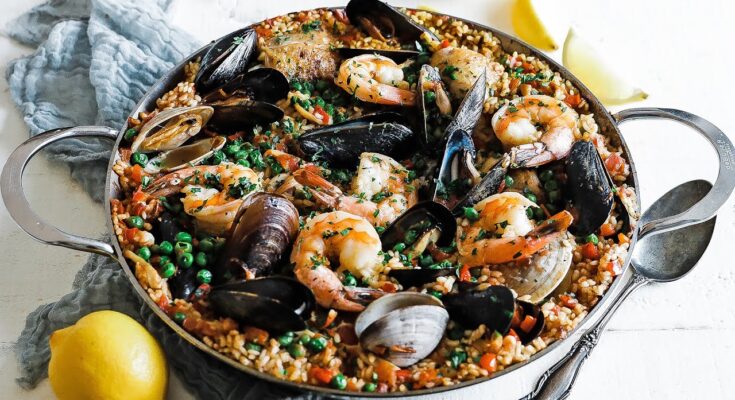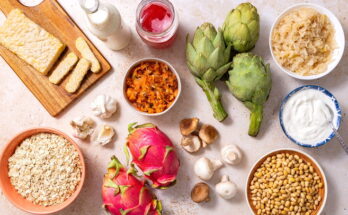Paella Recipe: Paella, a traditional Spanish dish, is known for its vibrant colors, incredible flavors, and social, celebratory feel. Originating in the Valencia region of Spain, Paella has become a beloved meal worldwide.
While there are many varieties of Paella, from seafood to vegetarian, the core principles remain the same: high-quality rice, flavorful saffron, and a perfectly crafted cooking process.
Here, we’ll walk you through a step-by-step guide to preparing an authentic, crowd-pleasing Paella at home.
What is Paella?
Paella is a flavorful rice dish that holds a special place in Spanish cuisine. Originating as a rural dish in Valencia, Paella was initially prepared outdoors by workers using ingredients readily available in the fields. Today, it’s known worldwide and enjoyed in various forms, including Valencian Paella (typically made with rabbit, chicken, and beans), Seafood Paella (featuring mussels, shrimp, and clams), Mixed Paella (a combination of meat and seafood), and Vegetarian Paella (focusing on seasonal vegetables).
The name “Paella” is derived from the Latin term “patella,” referring to the wide, shallow pan in which it’s traditionally cooked.
Essential Ingredients for Traditional Paella
Creating the perfect Paella requires fresh, high-quality ingredients, particularly when it comes to rice and saffron. Let’s explore the essential ingredients you’ll need for a classic Paella.
- Rice: Choosing the right rice is crucial, with short-grain varieties like Bomba or Calasparra being preferred for their ability to absorb liquid without becoming mushy.
- Saffron: This aromatic spice gives Paella its signature golden color and unique flavor.
- Stock: A good stock is essential to add depth to the dish. You can make a homemade stock using seafood shells, meat bones, or vegetable trimmings.
- Proteins and Vegetables: Common proteins include chicken, rabbit, seafood, or a combination, depending on the Paella style.
Tools and Equipment Needed
To achieve the best results, having the proper equipment is essential.
- Paella Pan: A wide, shallow pan helps ensure even cooking. If you don’t have one, a large skillet or flat-bottomed pan will work, though it might not yield the same crispiness in the socarrat (the golden crust).
- Burner or Stovetop: Traditional Paella is cooked over an open flame, but you can also use a stovetop or outdoor grill for even heat distribution.
Choosing the Right Rice for Paella
Selecting the correct rice can make or break your Paella. Spanish short-grain varieties like Bomba or Calasparra are ideal, as they absorb a substantial amount of liquid while keeping each grain distinct. If you can’t find these, Italian Arborio rice is an acceptable substitute, though it may yield a creamier texture.
Step-by-Step Paella Recipe
Let’s dive into the process of making an authentic Paella.
Step 1: Prepare the Ingredients
Start by gathering and prepping all your ingredients. Chop your vegetables, clean the seafood (if using), and cut any meats into bite-sized pieces. This helps streamline the cooking process.
Step 2: Prepare the Stock
A homemade stock provides a robust base flavor for your Paella. For seafood Paella, simmer shrimp shells, fish bones, and aromatic vegetables. For meat-based Paella, a chicken or rabbit stock works well. Let it simmer for at least 20-30 minutes to fully develop the flavors.
Step 3: Sauté the Aromatics and Vegetables
In your Paella pan, heat olive oil over medium heat. Sauté garlic and onions until fragrant, then add vegetables like bell peppers, tomatoes, and green beans (for traditional Valencian Paella). Stir occasionally to avoid burning, aiming for softened but not browned vegetables.
Step 4: Add the Rice and Saffron
Once the vegetables are softened, add the rice to the pan. Stir to coat the grains in oil and aromatics for a few minutes. Dissolve saffron in a small amount of hot water, then pour over the rice, giving it a warm yellow hue.
Step 5: Arrange Proteins and Add Stock
Now, arrange your proteins over the rice. Pour in the prepared stock until it covers the rice and ingredients completely. Resist the urge to stir at this stage—Paella is traditionally not stirred during cooking, which helps form the socarrat.
Step 6: Simmer and Let the Paella Cook
Reduce the heat to medium-low, allowing the rice to simmer. The rice will absorb the stock and cook evenly, creating distinct, flavorful grains.
Step 7: Create the Socarrat (Golden Crust)
Toward the end of cooking, increase the heat briefly to form a crispy layer at the bottom of the pan, known as the socarrat. This adds an authentic texture and a hint of smokiness.
Step 8: Rest and Garnish the Paella
Once cooked, remove the Paella from heat and cover it with a cloth or lid for 5 minutes. Garnish with fresh parsley, lemon wedges, and any desired herbs for an added burst of flavor.
Tips for Cooking Paella to Perfection
- Control Heat: Start with medium heat and adjust as needed, especially when forming the socarrat.
- Don’t Stir the Rice: Stirring makes the dish creamy, which isn’t the goal with Paella.
- Use Quality Ingredients: Fresh ingredients, high-quality saffron, and proper rice ensure the best outcome.
Common Variations of Paella
- Valencian Paella: Traditional version with rabbit, chicken, and green beans.
- Seafood Paella: Uses shellfish, squid, and fish.
- Mixed Paella: Combination of meats and seafood.
- Vegetarian Paella: Emphasis on seasonal vegetables and legumes.
Serving and Pairing Suggestions
Paella is best served family-style, directly from the pan. For a true Spanish experience, pair it with Spanish wine or sangria.
How to Store and Reheat Leftover Paella
If you have leftovers, store them in an airtight container in the fridge for up to two days. Reheat gently on the stovetop, adding a splash of water to prevent drying.
FAQs about Paella Recipe
1. What ingredients are needed for authentic Paella?
Traditional Paella includes a variety of ingredients such as short-grain rice, saffron, olive oil, garlic, onions, tomatoes, bell peppers, seafood (like shrimp, mussels, and clams), chicken, rabbit, and vegetables like green beans and peas. The exact ingredients can vary depending on regional preferences.
2. Can I make Paella without seafood?
Yes, Paella can be adapted to suit various dietary needs. A common variation is “Paella de Carne,” made with chicken, rabbit, and other meats instead of seafood. Vegetarians can also enjoy Paella by substituting meat and seafood with a mix of vegetables and legumes.
3. How long does it take to cook Paella?
Typically, Paella takes around 30–45 minutes to cook, depending on the type of ingredients and the heat source. Preparing ingredients beforehand can speed up the process, and cooking on medium heat helps ensure the rice cooks evenly.
4. What type of rice is best for Paella?
The best rice for Paella is a short-grain variety like Bomba or Calasparra rice, known for its ability to absorb flavors while maintaining a firm texture. Avoid long-grain rice as it doesn’t yield the traditional Paella consistency.
5. Can I cook Paella without a Paella pan?
While a Paella pan is ideal for its shape and heat distribution, you can also use a wide, shallow skillet. Make sure the pan can hold the ingredients in a thin layer for even cooking and the signature socarrat (crispy bottom layer of rice).
6. How do I get the perfect socarrat in Paella?
To achieve the prized socarrat, increase the heat toward the end of cooking. Listen for a light crackling sound and watch carefully to avoid burning. Once a golden crust forms at the bottom, the Paella is ready.
7. Can I reheat Paella?
Yes, Paella can be reheated, though it’s best enjoyed fresh. Reheat it in a pan over medium heat to maintain its texture. Adding a small amount of water can help prevent the rice from drying out during reheating.
Conclusion
To make a perfect Paella, follow the steps carefully: choose fresh ingredients, prepare a rich broth, layer in the rice, and let it cook to absorb all flavors. A well-made paella has a balance of seafood, meat, and vegetables, and the rice should be infused with the aroma of saffron and spices.
Now, it’s your turn to bring this dish to life! Experiment with different ingredients to make the recipe truly your own. Paella is a versatile dish that can be tailored to suit any taste, so enjoy the process and share your creation with loved ones!
References
To ensure accuracy and provide additional depth, here are some reputable sources for further reading on crafting the perfect paella. These resources offer expert tips, variations, and insights into traditional techniques that can enhance your experience in making this iconic dish. Feel free to explore them for inspiration and to validate the information provided in this recipe.
- Spanish Culinary Academy – Offers a comprehensive guide on authentic paella ingredients and preparation methods.
- Food & Wine Magazine – Features expert advice on creating flavorful paella and common mistakes to avoid.
- The Paella Company – Provides detailed information on choosing the right type of rice, seasonings, and cooking equipment for paella.
- BBC Good Food – Includes a variety of paella recipes with tips for balancing flavors and achieving the perfect texture.
These sources are valuable for anyone looking to master the art of paella, from beginners to experienced cooks.



